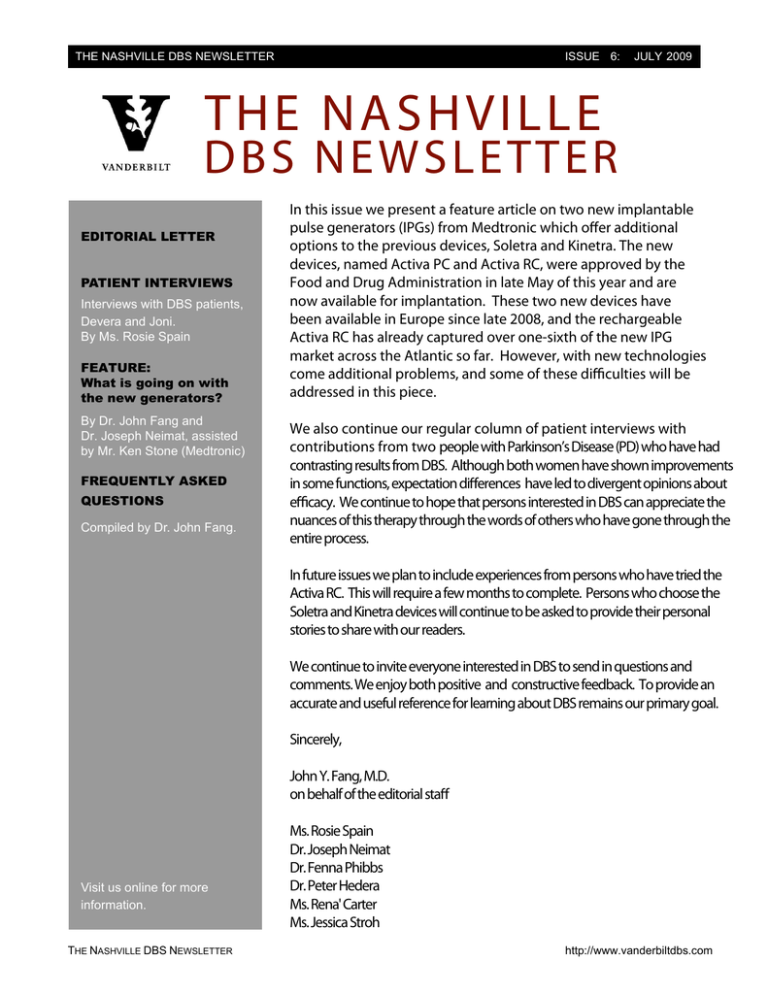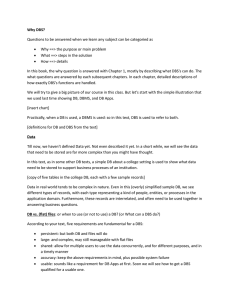THE NASHVILLE DBS NEWSLETTER
advertisement

THE NASHVILLE DBS NEWSLETTER ISSUE 6: JULY 2009 T HE NA SHVI L LE D B S NE WS L E T T ER EDITORIAL LETTER PATIENT INTERVIEWS Interviews with DBS patients, Devera and Joni. By Ms. Rosie Spain FEATURE: What is going on with the new generators? By Dr. John Fang and Dr. Joseph Neimat, assisted by Mr. Ken Stone (Medtronic) FREQUENTLY ASKED QUESTIONS Compiled by Dr. John Fang. In this issue we present a feature article on two new implantable pulse generators (IPGs) from Medtronic which offer additional options to the previous devices, Soletra and Kinetra. The new devices, named Activa PC and Activa RC, were approved by the Food and Drug Administration in late May of this year and are now available for implantation. These two new devices have been available in Europe since late 2008, and the rechargeable Activa RC has already captured over one-sixth of the new IPG market across the Atlantic so far. However, with new technologies come additional problems, and some of these difficulties will be addressed in this piece. We also continue our regular column of patient interviews with contributions from two people with Parkinson’s Disease (PD) who have had contrasting results from DBS. Although both women have shown improvements in some functions, expectation differences have led to divergent opinions about efficacy. We continue to hope that persons interested in DBS can appreciate the nuances of this therapy through the words of others who have gone through the entire process. In future issues we plan to include experiences from persons who have tried the Activa RC. This will require a few months to complete. Persons who choose the Soletra and Kinetra devices will continue to be asked to provide their personal stories to share with our readers. We continue to invite everyone interested in DBS to send in questions and comments. We enjoy both positive and constructive feedback. To provide an accurate and useful reference for learning about DBS remains our primary goal. Sincerely, John Y. Fang, M.D. on behalf of the editorial staff Visit us online for more information. THE NASHVILLE DBS NEWSLETTER Ms. Rosie Spain Dr. Joseph Neimat Dr. Fenna Phibbs Dr. Peter Hedera Ms. Rena' Carter Ms. Jessica Stroh http://www.vanderbiltdbs.com Q&A THE NASHVILLE DBS NEWSLETTER ISSUE 4 : NOV 2008 with DBS Patients in the Community Interview One : Devera Interview Two: Joni Can you tell us which symptoms in particular prompted you to have DBS? (for PD) Can you tell us which symptoms in particular prompted you to have DBS? (for PD) [My medications] caused me to sleep about 17 hours per day. My mornings were very tough with rigidity and nausea. How long did you wait to have DBS after you decided to have it done? My first meeting was in February, and after several tests [had] the [surgeries] in April. How long did it take for DBS to work? Activation was four weeks following surgery, and the effect was immediate. My tremors [were] eliminated, and for the first time in years I could get up and get on with my life. Dyskinesias. How long did you wait to have DBS after you decided to have it done? Six months. How long did it take for the DBS to work? We are currently still working on programming [it] to comfortable settings. What symptoms have not responded to DBS? I am still unable to lift my grandchildren up and feel this may be related to motor skills. Have you adjusted your typical daily activities as a result of DBS? I just started fending for myself again. I can eat, drink and walk. What expenses did your insurance not cover? So far all of my expenses have been covered by insurance. Have you noticed that you need less medication since surgery? No. Would you do it again? I am not really sure about that. In retrospect, would you have done anything differently in preparing for the surgery? Were there any complications during any of your surgeries? There were some painful headaches... for the first week. This may have been because I took a plane home 48 hours after surgery. Once these cleared, everything was fine. What symptoms have not responded to DBS? So far the only remaining symptom I have is central trunk tremor, visible as a tremor in my lower lip. Have you adjusted your typical daily activities after DBS? Yes, I get up in the morning without the past experience of setting the alarm for 6am to take meds and again at 9a, and eventually being mobile around 11a. Now I am up and about immediately. What expenses did your insurance not cover? Insurance covered most things [except] accommodations, meals and co-pays.. Have you noticed that you need less medication since DBS? From every three hours to every twelve hours. In retrospect, would you have done anything differently in preparing for the surgery? I knew what to expect. Having my family around was very supportive too. Not really. What advice would you give to someone else considering it? What advice would you give to someone else considering DBS? Do your homework, understand the procedure, and make an informed decision. Unequivocally this has worked for me, and I consider myself an advocate of the Vanderbilt team and its specific approach. Give surgery careful thought and consideration. N ASHVILLE DBS N EWSLETTER http://www.vanderbiltdbs.com THE NASHVILLE DBS NEWSLETTER ISSUE 3 : AUGUST 2008 Feature Presentation: What’s going on with the new generators? Background DBS was first utilized in humans for movement disorders in the 1980’s. Several different products have been developed over the years with colorful names from Itrel to Soletra to Kinetra, and now to Activa, the latest DBS device introduced this year. Each of these devices has individual features which influence its utility, ranging from size and weight to programmability and now the ability for recharging. The decision to implant a given device has typically been driven by both the individual patient characteristics and by body habitus. With the new Activa devices, patients will now have the opportunity to choose rechargeability as an optional feature. However, whether rechargeability (or any other option) should be chosen must be weighed carefully because once implanted, it is extremely difficult and costly to change devices. All patients considering DBS are strongly encouraged to discuss specific device options with their DBS doctors prior to making a selection. Please see A Surgeon’s Perspective for more insight into this choice. Review of the previous and current options Itrel devices were the first implantable pulse generators (IPGs) to be used widely. The Itrel II was the model designed for DBS, and was produced until 2000. The Itrel II permitted very limited patient programming and had an expected lifespan of three to five years. The Itrel could only control one side of the brain; two were required to control symptoms on both sides of the body. The Itrel could be turned on and off by a strong magnet. Soletra was introduced to replace the Itrel II, and offered more programming options for your doctor, but did not allow patient programming. Similar to the Itrel, two Soletra units were necessary to treat bilateral symptoms. With the Soletra also came a specialized patient access device to turn it on or off. The Soletra was also designed to last about three to five years, depending upon individual patient needs. The Kinetra was introduced both to allow patient programmability and to allow one device to control both sides of the brain. The Kinetra was made larger than the Soletra (or Itrel II) in order to accommodate a THE NASHVILLE DBS NEWSLETTER larger battery. The Kinetra also required a specific access device to turn on and off and to change settings within predetermined parameters determined by your doctor. The Kinetra was designed to last about three to five years with bilateral use, but expected life could be doubled if unilateral (one sided) use was selected. [Note that unilateral use is not the typical application of the Kinetra.-ed] Onward to the Activa PC and RC The newest devices to be introduced are called Activa PC (for Primary Cell) and RC (for Rechargeable Cell). These devices both allow patient programmability and come with a specific access device that includes all of the basic functions of the Soletra and Kinetra plus a few more. Both Activa PC and RC IPGs have increased functionality over Soletra and Kinetra. For many patients the additional programming options will not be noticeable, but for some individuals, there may be advantages. [As noted in a prior issue of this Newsletter, a device currently under study by St. Jude Medical also has increased functionality versus Soletra and Kinetra.-ed] The Activa RC also requires a recharging unit. It is estimated that the typical user will require four hours to recharge the IPG every week. Alternatively, thirty minutes per day may work well for many patients. A Surgeon’s Perspective Although the choice of pulse generator is a largely personal decision, patients seeking guidance might consider the following recommendations: 1) Although the Activa RC is smaller, it must be implanted closer to the skin surface to be properly charged. Thus, there may be little cosmetic advantage except in patients with the most slender builds. In general, implantation of an Activa PC below the muscle can provide good coverage for patients. 2) The procedure to replace a pulse generator is a low risk outpatient procedure. Many patients may prefer to have this procedure more frequently (eg. 5 yrs) vs. recharging. 3) Patients who are very thin or who anticipate requiring a very high voltage setting will likely be happiest with the rechargeable . Your neurologist/neurosurgeon team can help you anticipate if high voltages will necessary. Your neurosurgeon and neurologist will be happy to discuss the options with you and show you the actual generators to help you make the decision that is best for you. http://www.vanderbiltdbs.com THE NASHVILLE DBS NEWSLETTER Frequently Asked Questions Who should get the new DBS IPGs? Which IPG choice is going to turn out to be the best for a given individual may turn out to be an after-the-fact determination, meaning that it may not be possible to say unless both are tried. However, several pointers have been suggested to help make this decision. ISSUE 3 : AUGUST 2008 Some insurance companies may cover the replacement cost under a personal property clause or under medical coverage. Anyone with DBS should check with his or her insurance company or companies to inquire about replacement coverage. What is the size comparison of the IPGs? For persons interested in the Activa RC IPG all of these conditions should be true: 1) Not be entirely dependent upon others for care 2) Fully understand the commitment required, including recharging when away from home 3) Take medications exactly as prescribed 4) Be able to recognize if DBS therapy has been interrupted and be able to seek prompt medical attention in that case 5) Be able to assemble and to place the shoulder belt properly (for recharging) 6) Be able to distinguish between the DBS Patient Programmer and DBS Recharger which look similar. Your DBS team doctors will also need to determine whether your condition (ET, PD, or dystonia) is suitable for the Activa RC. Cost may also be a factor as the Activa RC is considerably more expensive than the other devices. The Kinetra is also planned to be discontinued within the next couple of years. This photo shows the relative size of the Activa RC (top left), Soletra (top right), Activa PC (bottom left), and Kinetra (bottom right), in order of increasing size. How long does it last? The actual dimensions are as follows: The Soletra, Kinetra, and Activa PC batteries are designed to last about three to five years, often longer. The Activa RC battery is designed to last nine years assuming that it is recharged regularly. Without recharging the Activa RC will stop functioning in about two weeks. The actual battery life of the Soletra, Kinetra, and Activa PC can vary considerably (eg. plus or minus three years) depending upon the settings that have been programmed by your doctor. The Activa RC will turn off after nine years and cease to function regardless of programmed settings. What is the cost of replacing the Patient Access programmer? Currently, the replacement cost is as follows: 1) Soletra - approximately $600 2) Kinetra - approximately $700 3) Activa PC and RC - approximately $1000. THE NASHVILLE DBS NEWSLETTER Activa RC = 2.1” x 2.1” x 0.4” (1.4 oz) Soletra = 2.2” x 2.4” x 0.4” (1.5 oz) Activa PC = 2.6” x 1.9” x 0.6” (2.4 oz) Kinetra = 2.4" x 3.0" x 0.5" (2.9 oz) Note that two Soletra IPGs are required for bilateral stimulation; only one of the other IPGs is needed. Also, the recharging shoulder belt and DBS Recharger will add weight when in use for the Activa RC. Aren’t the Itrel II, Soletra and Kinetra also known as “Activa”? Afficionados of DBS may recognize the name “Activa” as that used by Medtronic for the entire DBS system. Users are cautioned not to interchange the Activa system with the Activa IPGs, as technically the discontinued Itrel II and both the Soletra and Kinetra are components of the Activa system as well. http://www.vanderbiltdbs.com


